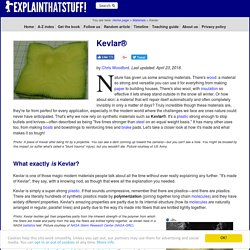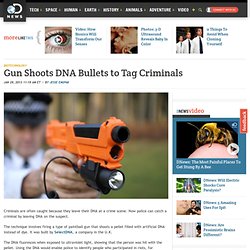

World Standards. Cultural References.
Why is Kevlar so strong? Advertisement by Chris Woodford.

Last updated: April 23, 2018. Nature has given us some amazing materials. There's wood: a material so strong and versatile you can use it for everything from making paper to building houses. There's also wool, with insulation so effective it lets sheep stand outside in the snow all winter. Photo: A piece of Kevlar after being hit by a projectile. What exactly is Kevlar? Kevlar is one of those magic modern materials people talk about all the time without ever really explaining any further.
Kevlar is simply a super-strong plastic. Photo: Kevlar textiles get their properties partly from the inherent strength of the polymer from which the fibers are made and partly from the way the fibers are knitted tightly together, as shown here in a NASA ballistics test. Real Time Crime Center. Real Time Crime Center emblem The Real Time Crime Center (RTCC) is a centralized technology center for the New York (NYPD) and Houston Police Departments.[1][2] Its purpose is to give field officers and detectives instant information to help identify patterns and stop emerging crime.

History[edit] The RTCC opened on July 18, 2005 and provides support 24/7. The center was built at a cost of $11 million. The information in the center is available to the 37,000 police officers of the New York City Police Department. Technology[edit] RTCC data sources include a data warehouse in which billions of records are made available to detectives and other officers within minutes, instead of days or weeks. More than 5 million New York State criminal records, parole and probation files,More than 20 million New York City criminal complaints, arrests, 911/311 calls and summonses spanning five years,More than 31 million national crime records,More than 33 billion public records.
References[edit] CGS : DNA Forensics. Forensic Anthropology. As of July 1, 2013 ThinkQuest has been discontinued.

We would like to thank everyone for being a part of the ThinkQuest global community: Students - For your limitless creativity and innovation, which inspires us all. Teachers - For your passion in guiding students on their quest. Partners - For your unwavering support and evangelism. Parents - For supporting the use of technology not only as an instrument of learning, but as a means of creating knowledge. We encourage everyone to continue to “Think, Create and Collaborate,” unleashing the power of technology to teach, share, and inspire. Best wishes, The Oracle Education Foundation. Forensic Science Central - Home. Gun Shoots DNA Bullets to Tag Criminals. Criminals are often caught because they leave their DNA at a crime scene.

Now police can catch a criminal by leaving DNA on the suspect. The technique involves firing a type of paintball gun that shoots a pellet filled with artificial DNA instead of dye. It was built by SelectDNA, a company in the U.K. The DNA fluoresces when exposed to ultraviolet light, showing that the person was hit with the pellet. Using the DNA would enable police to identify people who participated in riots, for example. DNA Could ID Serial Killer’s Victims Each batch of pellets has its own DNA signature, so a person who was hit with one could be tied to certain event, since a police officer would be using different pellets on different days.
It’s even possible to identify people long after the fact: the DNA, according to the company, sticks to clothing through several washings and to skin for about two weeks. The use of the tagging guns by police, though, raises questions. Via Popular Science, SelectDNA. SelectaDNA High Velocity DNA Tagging System. Home > SelectaDNA High Velocity DNA Tagging System A High Velocity DNA Tagging system that keeps criminals at arm's length has been launched at The SHOT Show, Las Vegas.

Identifying an individual in a crowd or at a distance can be challenging for law enforcement officers and police especially when they are in riot situations or experiencing crowd control problems. Available in pistol and rifle form, this new and practical concept allows police and military to remain at a safe distance (up to 30-40 metres) from a potential target while deploying the SelectaDNA High Velocity pellet. By using the new SelectaDNA High Velocity System, a uniquely-coded DNA pellet can be used to mark an individual so that they can be apprehended at a less confrontational time for officers.
Fingerprints Lifted from Fabric. Scottish police have paired up with forensics experts from the University of Abertay Dundee to make lifting fingerprints from fabric possible for the first time.

The technique, which has been around since the 1970's, was only usable on smooth surfaces. But researchers have now figured out a way to use it on fabric. Specifically, the process is called vacuum metal deposition (VDM) and works like this: Forensics scientists put fabrics into a vacuum chamber, where gold can be evaporated and spread evenly as a thin film onto the material. Then they do the same thing with zinc, which attaches to the gold only in areas that haven't been touched by hands. The final picture looks like a film negative, revealing the miniscule skin ridges that form the characteristic whorls, loops and arches of a hand or fingerprint.